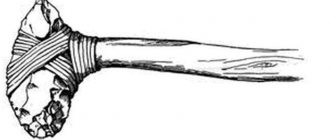Considering the historical process in its forward movement, we will see that man constantly fought: he fought for cattle and women, land and money, faith and the Fatherland. It is war that is the constant companion of progress.
Since with the development of civilization the equipment of warriors also developed, weapons, accordingly, also changed quickly and became more and more advanced and dangerous. Today we will talk about the ax - a weapon of medieval warriors, which has not lost its relevance to this day.
Where does the ax come from?
Ax - one of the types of battle axes is distinguished by a special blade in the shape of a crescent. Such weapons were common back in the 1st millennium in Ancient Greece, but from the Iberian Peninsula they quickly spread throughout the continent and became known not only in Europe, but also in Asia.
At that time, the ax had two blades located along the handle like a butterfly. Such a double-sided ax was capable of much in the hands of an experienced warrior; the long handle ended with a point, so it could both chop and stab.
The two-handed ax was very popular among infantry; it was intended for attacking horsemen and tearing metal armor.
Like a battle axe, the ax is a destructive weapon of enormous power, but it is lighter and, due to its long handle, has better balance, which gives the warrior the opportunity to maneuver during battle.
And although in our time there are various types of weapons of mass destruction, the popularity of battle axes has again risen due to their versatility, size and ability to be used in extreme conditions.
Bow and arrows
Although the Vikings were famous for their unrivaled close combat skills with the battle axe, this was not the only fighting style they mastered.
They quickly realized that the bow and arrow, which was originally intended for hunting, could also serve as a very dangerous weapon.
A skilled archer would fire about twelve arrows per minute before engaging in the inevitable hand-to-hand combat.
This skill allowed the Vikings to shower the enemy with a hail of arrows from the deck of the ship before going ashore and spilling the enemy's blood.
Distant ancestor of the battle ax
The ancestor of the battle ax was the two-edged labrys, which originated in Ancient Greece and is a symbol of divine power. The functions of these weapons were combat, religious, and ceremonial. Since it was very difficult to make such weapons, they were available only to kings and priests.
An ax with two blades arranged in a butterfly pattern on either side of the shaft required enormous strength and dexterity to use in battle. A warrior armed with a labrys and covered with a shield was invincible and, in the eyes of those around him, was endowed with divine strength and power.
Literature
- Zharkov S.V.
Vikings. The first illustrated encyclopedia. - M.: Eksmo, 2018. - 752 pp.: ill. — Series “The Best Warriors in History.” — ISBN 978-5-04-090373-3. - Oakeshott Ewart.
Weapons and military armor of Europe. From ancient times to the end of the Middle Ages. - M.: ZAO "Tsentrpoligraf", 2009. - 704 p. — ISBN 978-5-9524-4069-2, 9785952440692. - Petersen Jan.
Norwegian Viking Age swords. Typochronological study of weapons of the Viking Age. - St. Petersburg: Alpharet, 2005. - 352 pp.: ill. — ISBN 5-902882-06-0. - Heath I.
Vikings. Story. Armament. Tactics / Transl. from English V. E. Kachaeva. - M.: LLC "AST", Astrel 2004. - 64 p.: ill. — Series “Elite Troops”. — ISBN 5-17-021798-6. - Tsepkov A.I.
Viking armament in the 9th–11th centuries. According to the Icelandic sagas and the “Earthly Circle”. - Ryazan: Alexandria, 2013. - 320 p. - Chartrand R., Duram K., Harrison M.
Vikings. Sailors, pirates, warriors. - M.: Eksmo, 2008. - 192 p. — Series “Military History of Humanity.” — ISBN 978-5-699-23504-9, 9785699235049.
- Ewart Oakeshott: The Sword in the Age of Chivalry
, 1994, ISBN 978-0851153629 - Alan R. Williams, Methods of Manufacture of Swords in Medieval Europe: Illustrated by the Metallography of Some Examples,
Gladius 13 (1977), pp. 75 – 101. - M. Müller-Wille: Ein neues ULFBERHT-Schwert aus Hamburg.
Verbreitung, Formenkunde und Herkunft , Offa 27, 1970, 65-91 - Ian Peirce: Swords of the Viking Age
. The Boydell Press, 2002, ISBN 978-0851159140 - Anne Stalsberg “The Vlfberht Sword Blades Re-evaluated”
- Alan Williams “A Metallurgical Study of Some Viking Swords”
Description of the ax
The ax is a bladed weapon from the family of battle axes, common in the Middle Ages. Its main difference from an ax is the shape of the blade in the shape of a crescent. In addition, the ax had a longer shaft, which made it possible to balance in battle and not allow the enemy to come close to you.
In addition, the ax could not only chop, but also stab.
Therefore, it can be argued that the ax is an ax and a sword and a spear at the same time. The first axes consisted of a shaft, a blade and a counterweight. Sometimes the shaft was strengthened, and its length varied depending on its functions:
- for infantry it was made from two to two and a half meters;
- for boarders - sea pirates who attack ships, it was more than three meters long and large hooks were also welded to the ax for ease of use;
- for cavalry - the shaft was prepared less than a meter.
The length of the ax blade also varied from a few centimeters to a meter, and the lower part of the blade had protrusions for more reliable attachment to the shaft.
Such weapons were universal: they were used for attack and defense, and for pushing warriors off their horses, and for robbing rich merchant ships.
Many European armies had special units armed with these axes to protect their flanks.
The process of making an ax looks like this:
Material selection
The following grades of wood are used for the handle:
- oak;
- birch;
- maple and some others.
In order for this part to be of high quality, the wood must be harvested before frost. After the workpieces are ready, they need to be dried. They should lie in a ventilated area for about a year. But, some craftsmen claim that the drying period should be about 5 years. In fairness, it must be said that in an emergency, you can use an undried workpiece, but this is a temporary option, the handle will quickly wear out.
Cutting out the template
To obtain an ax of the required size, you must use a template made from cardboard. As a sample, to obtain it, you can use the tool that is convenient to work with. That is, you need to put it on a sheet of thick cardboard and outline it with a pencil.
Ax template
By the way, the size of the ax can be determined based on the height and physique of the person who will work with it.
Making a blank
A block is hewn out from a block that has been dried. Work must be carried out along the fibers. The size of the bar should be 100 mm larger than the size of the finished product. The size of the part where it will be installed, and the blade itself should be 2 - 3 mm larger than the size of the eye.
The template prepared in advance must be laid on the surface of the block. At the same time, leave allowances for processing. From the front its size is 10 mm, in the tail it is 90 mm. This allowance is necessary so that the handle does not crack when pulled onto the ax itself. Upon completion of work, this allowance is removed.
Hewing out an ax
To bring the part to the required dimensions, two cuts must be made in the upper and lower parts of the workpiece, but their depth should not reach the contour of 2 mm. Excess material can be removed using a chisel. After this, using a file with a large notch, the corners, transitions and other surfaces of the handle are leveled. Abrasive sandpaper is used to finish the surface.
Making an ax
Impregnation with waterproof compound
To increase the resistance of the handle to moisture, special compounds are used. But it is permissible to use drying oil or linseed oil. The handle is covered with this liquid until it stops being absorbed into it.
By the way, it wouldn’t hurt to add a coloring pigment, for example, orange, to the waterproof coating. Then the tool with a bright handle will not disappear on the site.
Legendary Viking weapons
Normans, Vikings, Varangians - words that terrified all the peoples inhabiting Europe, since the world did not know more bloodthirsty and powerful warriors at that time.
Armed with Scandinavian axes, otherwise called Danish or heavy battle axes, the Vikings did not know defeat in battle and always took rich booty and took away captive slaves.
The main difference between this weapon was its wide, heavy blade, which could instantly cut off a person’s head or limbs. Mighty warriors masterfully wielded axes for battle, work, and tournaments.
In Kievan Rus, which had close trade ties with the Scandinavian countries, battle axes looked like siblings of the Viking axe. For the Russian foot army, axes and axes were the main type of weapons.
Final word
There is hardly a man who will not be happy with such a gift. But that's not even the main thing. If a home craftsman once makes such beauty with his own hands, then he will definitely be captivated by the activity, and he won’t be able to stop after that. And with the experience that comes, everything will turn out better and better. For example, you can master the technique of gilding (brass plating). After all, there is no limit to perfection. And if learning brings pleasure, then it will be doubly effective. And regarding such products, it’s not for nothing that experienced blacksmiths say that a beautiful knife or ax is music enclosed in steel...
The Homius editors invite home craftsmen and craftsmen to become co-authors of the “Stories” section. Useful first-person stories will be published on the pages of our online magazine.
Previous STORIES A “floating” heart as a gift to a loved one - original and insanely simple Next STORIES Sleight of hand and a couple of minutes of work: practical ideas for using packaging
The most popular axes
Since the ax was a fairly common weapon in the Middle Ages, its appearance was varied depending on the functions that it had to perform.
Starting from the 1st century, Scandinavian axes, well known on the Scandinavian Peninsula and northern Europe, became widespread, but at the same time their appearance also changed.
Since the Scandinavian ax is heavy, and not every warrior will be able to maneuver in battle with an ax that weighed so much that it was not easy for a weak person to lift it, it was replaced by halberds and reeds.
And the brodex turned into an executioner's ax, since its wide, heavy blade made it possible to quickly separate the head from the body.
The one-sided ax became a tool of labor; with its help, lumberjacks felled hundred-year-old trees and cut off huge branches. With such a tool it was easy to turn a log of any size into timber.
In the 14th-15th centuries in Germany, Sweden and the Netherlands, foot soldiers used halberds - edged weapons with a long, up to 3 meters, shaft, which ended with a sharp pike and a small light blade in the shape of a crescent.
With such weapons, the mercenaries easily dealt with mounted knights, pulling them off their horses using hooks specially attached to their weapons, and finished the job with axes and swords.
Some halberds look like axes, others like hammers, and sometimes resemble a cross between a spear and a two-handed sword.
Berdysh is a special type of ax mounted on a long, up to two meters, shaft and a curved blade that resembles an elongated crescent in appearance.
The reeds used by mounted warriors were somewhat smaller and lighter, and small holes were made in them along the entire length of the blade into which rings were threaded.
When the armor of knights became lighter in the 16th century, the berdysh also fell out of use, since sabers and swords made of hardened metal easily pierced light chain mail.
The Wallachian battle hatchet was called Wallachka, after the name of the area from where it came to us. Having a long shaft and a relatively small blade, strongly protruding forward, the valashka was both a weapon, a staff, and a tool.
This weapon gained enormous popularity among ordinary people during the time of Vlad the Impaler, and in the 14th and 15th centuries this hatchet was chosen by shepherds and hunters.
In the 17th century, it was this hunter’s ax that became a symbol of the Serbian people’s struggle for independence from the Turkish yoke. At the same time, the battle hatchet (the sibling of the hammered ax) became a symbol of peasant uprisings in Rus'.
The history of the development of cold development in the world goes back thousands of years, each country can present its favorite models, but even today in almost every home there is a simple hatchet that, if necessary, can be turned into a terrible military weapon.
How to make it yourself
To make a throwing ax you will need an old or cheap axe, a grinder and wood.
- First you need to make the right head. To do this, you need to draw the shape of the weapon first on a piece of paper, then on the head of the axe. Cut off unnecessary metal using a grinder.
- Now you need to make an ax handle. It is advisable to make it from ash, as this material is very durable and flexible. These are the qualities that are necessary for a good handle. Cut the ax handle only from dry logs, otherwise the ax will soon break.
- We connect the head and the wooden ax handle. The weapon is ready for use!
Etching is the most important stage in hatchet making
For etching, it is best to use an inverter welding machine at a minimum current (30 A). As an electrolyte, a solution of water (3.5 l) and salt (700-750 g). Before starting work, it is better to check the intensity of etching on any piece of metal.
PHOTO: YouTube.com The electrolyte is ready, the welder is in place, you can start
Connecting elements to welding wires
First of all, a hatchet is attached to the positive cable, which is completely immersed in the electrolyte. But the negative contact needs some work. To increase the area immersed in the electrolyte, you can use a mounting plate for a metal profile. It should be curved so that the contacts are on both sides of the hatchet.
PHOTO: YouTube.com The mounting plate is perfect for etching
Etching procedure, inspection, protection of the welding machine
Having lowered the negative plate into the electrolyte, you need to make sure that both its sides are equidistant from the hatchet. Only after this can the welding machine be turned on. A violent reaction will begin almost instantly. It looks as if the electrolyte is boiling. In fact, this is not far from the truth; electrolysis does its job. Unpainted metal is etched away. No harm is caused to the painted surface; it remains untouched.
Etching is carried out in 5 passes. The welder turns off every 2 minutes to allow it to rest. It turns out that the total etching time is about 10 minutes. After this, the ax can be removed from the electrolyte.
PHOTO: YouTube.comThe electrolyte first boils and then turns dark
After the required time has passed, the hatchet can be removed from the container and the result can be assessed. If the etching depth seems shallow, you can continue. If everything is in order, then it’s time to remove the paint.
PHOTO: YouTube.comIf the etching depth is satisfactory, you can move on to the next stage
The final part of working with metal
The ax needs to be washed off the salt under running water and dried, then remove the paint from it. This can be done with fine sandpaper or acetone. Next, the entire surface must be polished. A felt circle mounted on an emery board or drill is perfect for this purpose. Only after polishing can you fully evaluate what the result of the work done is.
PHOTO: YouTube.com We can say that it turned out very well











